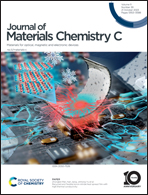Solution-processed amorphous zinc indium tin oxide thin-film transistors with high stability under AC stress†
Abstract
The stable operation behavior of thin-film transistors (TFTs) in pixel circuits under AC stress is crucial for high-performance active-matrix displays. However, conventional amorphous indium–gallium–zinc oxide (a-IGZO) TFTs exhibit a reduction in on-current (Ion) and the hump phenomenon of electrical characteristics when exposed to dynamic AC drain stress. In contrast, amorphous zinc–indium–tin oxide (a-ZITO) TFTs exhibit superior resistance to acceptor-like trap generation caused by impact ionization. The tetrahedral Zn site and strong chemical bonding of the Sn site in the a-ZITO network enhance defect tolerance against hot carriers, resulting in high stability against AC stress. This has been demonstrated through AC stress tests and capacitance–voltage (C–V) characterization for a-ZITOs with various Zn : In : Sn ratios of 2 : 1 : 1, 4 : 1 : 1, and 6 : 1 : 1. Compared to the Ion degradation rate of 69% for a-IGZO TFTs, the value significantly decreased to 15% by employing optimized a-ZITO with a synergistic composition ratio of 6 : 1 : 1. Overall, a-ZITO (6 : 1 : 1) TFTs exhibited high AC stress stability and a low threshold voltage shift of 0.4 V while maintaining high carrier mobilities of 10–11 cm2 V−1 s−1 with consistent performance regardless of the fabrication batch.



 Please wait while we load your content...
Please wait while we load your content...